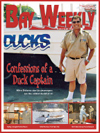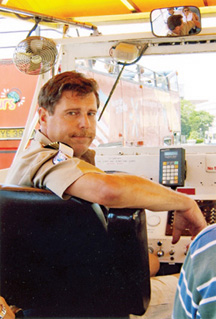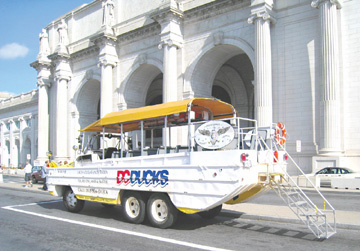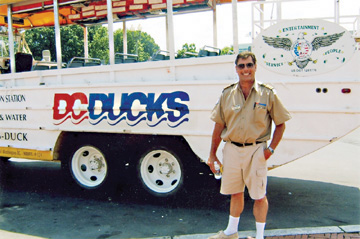
Volume XVII, Issue 42 ~ October 15 - October 21, 2009
Home \\ Correspondence \\ from the Editor \\ Submit a Letter \\ Classifieds \\ Contact Us
Dining Guide \\ Home & Garden Guide \\ Archives \\ Distribution Locations \\ Advertising
![]()

Search bayweekly.com
Search Google


 Confessions of a Duck Captain
Confessions of a Duck Captain
My passengers were the oddest ducks of all
by Allen Delaney
A certified Coast Guard captain, I was at the wheel of a D.C. Duck, an amphibious World War II-era vehicle converted for use as a tour mobile.
Indeed, I was on the verge of slamming my seven-ton, all-steel Duck into two fiberglass boats to bring it ashore at a public boat ramp along the Potomac River. A strong current pushed my stern starboard toward a docked boat. To compensate, I had to aim my bow to port, toward another docked boat. I jammed my Duck into reverse and gave it full power. If it hadn’t been for my passengers pushing us off a third boat docked at the far end of the ramp, there would have been several accident forms to fill out.
I maneuvered to the second ramp, which was now clear, and drove the boat up. My passengers cheered while I tried to stop hyperventilating. We were back on land, ready to resume our 90-minute tour through Washington, D.C.
That’s how I spent my summer: Ducking tourists through our nation’s capitol.
From One Kind of Nerd to Another
After 20-some years working with computers, I needed a change. For one thing, computer nerds get stuck in the worst room of a building since all we do is stare at a monitor. I had been in the same, windowless space — a converted women’s locker room — for the past nine and half years. You couldn’t even pick up a radio station down there. It was time to get out.
Three years ago, I happened to see the ad, Wanted: DC Duck Captains, while glancing through the Washington Post employment section. I never forgot that ad.
Little by little, I gathered the qualifications for the job. I began by signing up for a boat captain’s course. The basic captain’s license is called an Operator of an Un-inspected Passenger Vessel, more commonly known as a Six Pack, meaning I could only take out up to six people on a vessel.
With more class time, I expanded my license to a Master’s, enabling me to take out as many people as the boat (or Duck, in this case) can legally hold. After taking the Coast Guard test, drug tests, physicals, background checks, getting fingerprinted and obtaining a Transportation Workers Identification Card, I finally received my 25-ton Master’s License. (Boat tonnage is not the weight of the boat but rather the total enclosed space of a vessel, using 100 cubic feet per ton.)
I was then off to the local college to enroll in a Commercial Drivers License course. With my CDL, I worked on getting a passenger endorsement since I would be transporting 28 people at a time. All licenses in hand, I filled out my D.C. Duck application in October and got a call at the end of January. It was time for an interview.
Captain Larry, who would become my supervisor, informed me that I needed one more qualification to be a D.C. tour guide. I had to pass the District’s Tour Guide test. Inside the “bag of knowledge,” as Captain Larry called it, were about 800 index cards with addresses, photos of monuments, statues and buildings. I had to know what building was at each address and be able to identify every monument, statue and building. For two months, every night after dinner my wife quizzed me on each card. With her help, I passed the Tour Guide test. Now I was ready to go Ducking.
From DUKW to DUCK
About 21,000 DUCKS, officially known as DUKWs, were built by General Motors from 1942 to 1945, primarily to get supplies to the troops. At the DUKW’s core was a two-and-half-ton GM truck. A steel hull was wrapped around it, and a propeller, rudder and prop shaft was added. The propeller is powered by the truck’s drive shaft, and the rudder is controlled by the vehicle’s steering wheel. Pushing forward a shifter next to the driver engages the prop.
DUKWs sped up the supply chain. Deep-water ships could unload their cargo only at ports, which might be miles from base camp. DUKWs, however, could drive to the nearest beach and enter the ocean to meet the supply ship offshore. Supplies were tossed into the DUKW to be piloted to shore and driven to camp. Troops and supplies were ferried by DUKWs throughout the war. Because the vehicles could traverse both land and water, soldiers christened them DUCKS.
When the war ended, thousands of DUKWs, some working, some not, were abandoned by the Army. Today DUKWs flourish all over the world. They are used in parades, as rescue boats and as land and water tour mobiles.
 Gone Ducking
Gone Ducking
Driving a DUCK, a 31-foot-by-eight-foot vehicle, through the city is like trying to maneuver a tank through a china shop. The Duck captains who trained me had ample patience and nerves of steel.
You had to, to survive the quacking.
We were ducks, and once we entered the water, we captains were to give out small, plastic whistles that are supposed to sound like a duck. I quickly learned to hand out the quackers at the end of the tour. Trying to talk over a bunch of kids quacking was like trying to control a herd of squirrels. The usual comment from my adult guests was, I see why you hand those out at the end or You just made our ride home a lot longer.
After a month of ferrying tourists through the city, I had whittled them into four categories.
The Regulars. These were the folks who truly wanted to learn about the nation’s capitol and its history. They sat quietly as I drove and narrated, then boated, then drove some more. They were my favorite group.
The Talkers. Here were people paying $32 a ticket for this tour when all they did was yap to one another. Not about what they are seeing, noooo, but about inane items such as what they should add to their grocery list, or why they like real wood floors as opposed to laminate flooring. They could have had their conversation in a park for free.

![]() The Repeaters. Ninety-nine percent of the time, the Repeater was Grandma, making sure her grandchild got absolute fulfillment out of the tour. I would say, “And over to our left is the Washington Monument.” Then Grandma, who was usually right behind me, would say, “Look Johnny, there’s the Washington Monument!”
The Repeaters. Ninety-nine percent of the time, the Repeater was Grandma, making sure her grandchild got absolute fulfillment out of the tour. I would say, “And over to our left is the Washington Monument.” Then Grandma, who was usually right behind me, would say, “Look Johnny, there’s the Washington Monument!”
I would point and say, “To our right is the White House,” and Grandma would repeat, “Ohhh, look Johnny, that’s the White House.” I was often tempted to point out a pothole just to see if Grandma would say, “Look Johnny, a pothole in our nation’s capital!” Driving Repeaters was like having an evil parrot on my shoulder.
The Translators. This type, again, usually sat right behind me, translating to his or her non-English speaking father, nephew, friend, whoever. They were similar to the Repeater, except I imagined they were saying, Ah, the captain is an idiot! Let’s take over the boat once we are in the water!
My Next Career Move
Next summer, I’m thinking about getting off land and working only on the water. After taking a tour on the Spirit of Washington — a large ship that can accommodate almost 400 passengers — I am inspired to get my captain’s license upgraded to 100 tons. Then I won’t have to deal with any more public boat ramps.
© COPYRIGHT 2009 by New Bay Enterprises, Inc. All rights reserved.